Asustor Flashstor FS6712X NVMe NAS Power Consumption and Noise
Power consumption on this unit was interesting. First, it came with a 90W Delta power supply. This is an upgrade over the 65W Delta unit that came with the FS6707T.
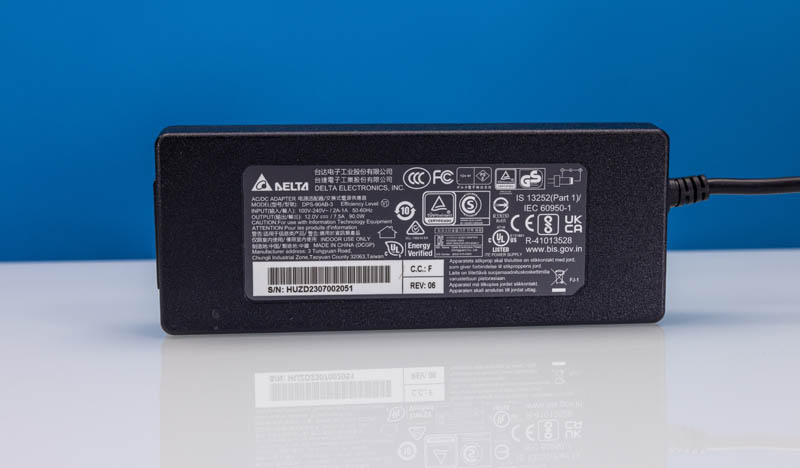
Idle power was also about double the 6-slot NAS at 23-26W with the 12x Crucial P3 Plus 4TB drives. Pushing 10GbE transfers from the NAS over the RAID 5 array got us to 34-42W. Again, this is going to depend a lot on the drives, and we are using very low-cost and fairly low-power SSDs.
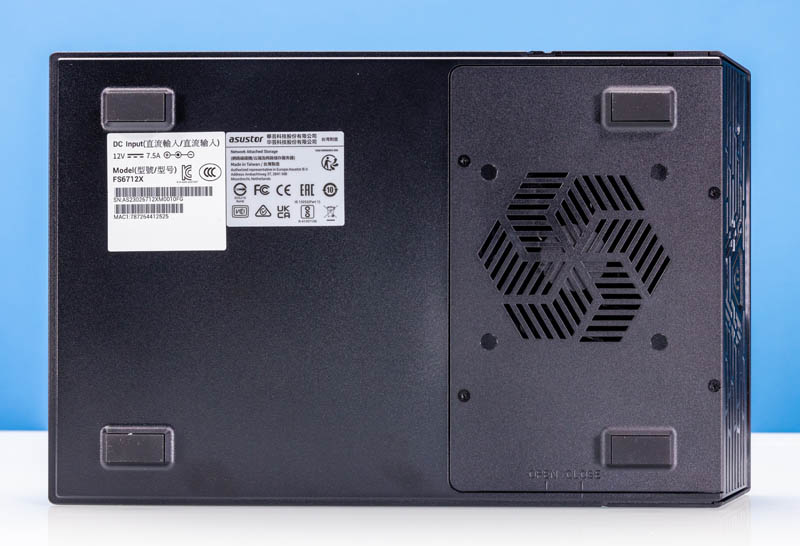
In terms of noise, both of the Flashstor units were very quiet. Adding ~1dba to our studio’s 34dba noise floor. This unit was slightly higher under prolonged transfers.
One area that was a concern was cooling. Here is a screenshot from the approximately 7-hour volume initialization process showing the drive temps. These temps were not off the chart, but there is limited cooling in this case with a single fan that is not blowing horizontally over all of the drives.
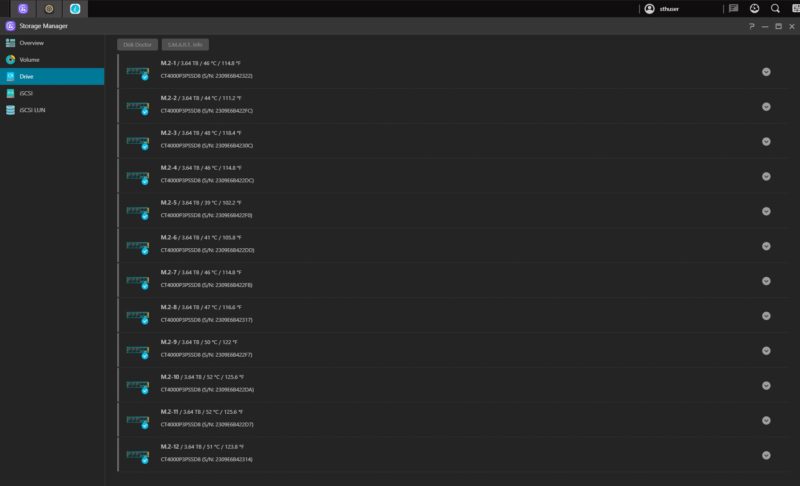
Overall the power and noise seemed reasonable. Moving to higher-power processors would probably mean more attention for cooling and so there seem to be trade-offs made.
If you want to know a perfect use-case for these, they are so quiet we can run them in the STH YouTube studio and they are not audible on the shelf in the background. For content creators, these are pretty interesting because they are low-power and quiet without the hard drive noises.
Key Lessons Learned
On the key lessons learned front, there were a lot of things that could be better with this NAS. There are simply too few PCIe lanes. Four screws to get to the bottom SSDs is too many. Cooling could be more optimal. The chassis feels too plastic-y whereas it would feel premium with thicker plastic or a metal chassis. 4GB of RAM should be 8GB at minimum on this model given the few dollars of extra cost. The inability to add another USB NIC was a bummer making the USB ports feel more as though they are just for external HDD enclosures.
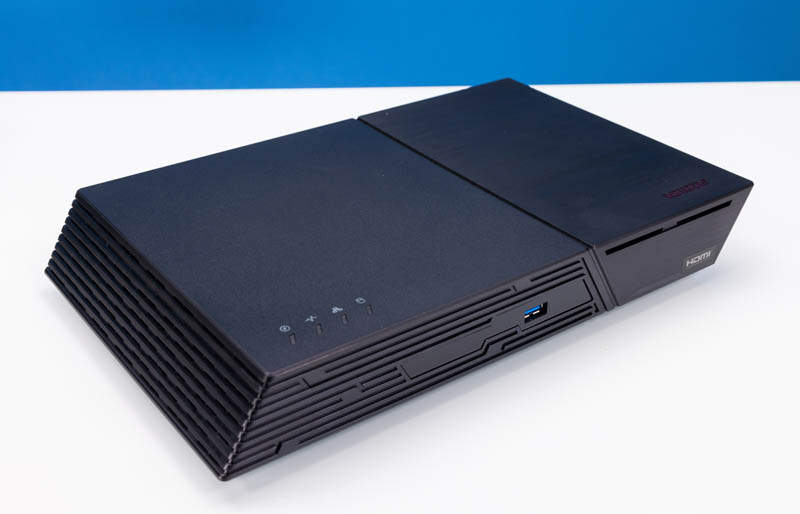
Still, with all of the above, this is a useful tool. The cost of the NAS is around $750. The cost of the SSDs is around $2700 for 48TB. There are not many elegant ways to get this much flash storage capacity onto a 10GbE network at that price and power consumption level. It is also very quiet. Hard drives may be cheaper, but if a hard drive NAS is in your office, you will hear the drives make noise. With the M.2 SSDs, there is no noise. This is one that can be powered on battery backup power easily sitting on a desk. Still, to do a M.2 NAS like this, you really have to want a M.2 NAS.
The mistake we made with the 6x M.2 version was that we only used 1TB SSDs. That capacity was simply too low to make sense with around 4TB usable. This NAS has around 40TB usable in a quiet form factor which is much more useful.
Final Words
When we first saw the Asustor Flashstor FS67 series announcement, our first thought was that this is a silly product. There are nowhere near the number of PCIe lanes to fully connect all of the SSDs and the 10GbE NIC. That “nowhere near” is to the point we need 6.5x the number of lanes this provides. That was the wrong way to look at the product.
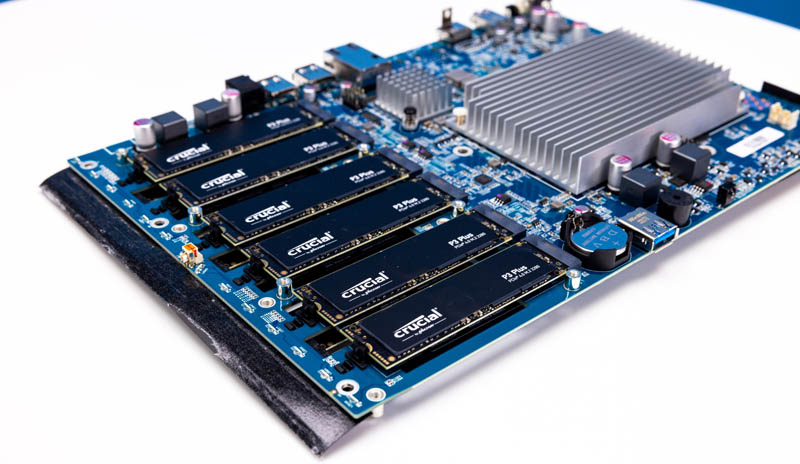
Instead, there were two factors at play. First, the 4TB M.2 NVMe SSD pricing has fallen like a rock. 8TB drives are too expensive to be practical for a form factor like this. 1TB drives are too small. The 4TB drives at under $225 each make a really intriguing combination. The other factor was really to start thinking of this from the network side. This is a 10Gbase-T NAS, not the highest-performance possible NAS. Asustor was only trying to provide enough performance to saturate the 10GbE link. If you want more performance than that, then it is worth looking at other solutions.
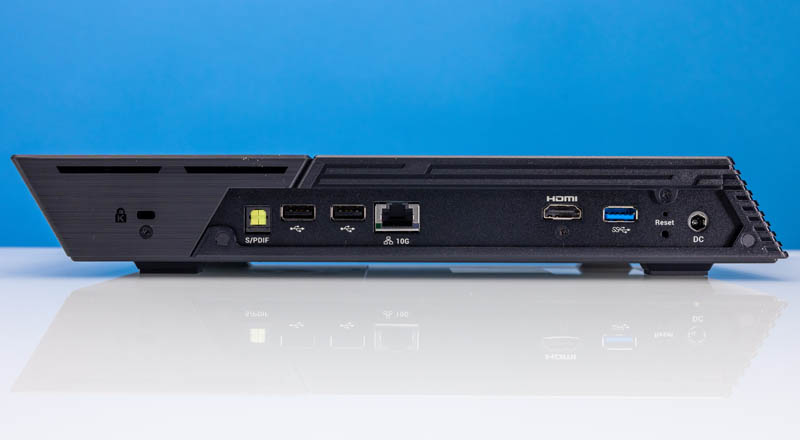
Still, if you want a NAS with a decent capacity, that has 10GbE speeds, no moving noisy hard drives, and that is relatively low power and quiet, then the Asustor Flashstor 12 Pro FS6712X ended up being a great device. We went from our initial expectation that this is a silly product to realizing it is actually quite useful.




Definitely looks interesting. Kind of disappointed that the speed seems so low. I get that they had to use a low powered CPU to keep the power/heat low but those nvme drives are restricted (even with the pci switch it seems). If you’re dropping $2.5k on this machine, you would expect better performance.
Hopefully they’ll come out with an updated version that at has more pcie lanes because the power efficencies alone would make me consider moving from my HDD NAS that idles around 100W.
useful enough is neither a product that delivers on its promises nor indispensable with 12 NVMe SSDs much much more was to be expected
I have one of these. Opted to just load Linux on it, being it’s basically a standard x86 PC that didn’t take doing anything special. There is an 8 GB emmc storage built in that can act as the boot loader drive allowing you to put your / onto your main disk pool if you want. Overall I’m happy with it. I did opt to swap the fan and run the quieter fan at full all the time. This original fan just didn’t sound smooth for whatever reason so even though the new fan is running max all the time it’s actually quieter on top of delivering better airflow. I also decided to do the 2×16 GB. The processor is only listed as supporting 16GB so expecting it to do 4x as much seemed to be asking for trouble. No issues with 32 GB yet though. The only other thing I’d say is the power button is in a really awkward place, right under the overhanging ledge on the side where you’d naturally want to pick the box up from.
The upcoming AMD Epyc Sienna platform would be much more interesting for something like this. Much more expensive, but still. You could cram stupid amounts of M.2 drives into a 1U case, or 2U if you wanted more tolerable fan noise and room for a PCIe slot or two.
“If you want more performance than 10GbE, then it is worth looking at other solutions.”
I would say if you want more performance than 10GbE, then you are an enterprise, not a home user.
Looks like this supports Ext4 and Btrfs? How reliable is Btrfs? Are they doing the same trick as Synology where they still use the more reliable mdadm to manage the RAID array and then just format the individual drives as Btrfs?
Can you run TrueNAS on this? Is the network card supported?
This would have been somewhat more interesting with a part like the Atom P5322 or Xeon D-1702. Without ECC and with such poor PCIe resources this is a bit of a joke.
If the Crucial P3 Plus is such a bad drive (as documented in your own review), why did you choose to use it here?
Wouldn’t choosing the P3+ imply that it isn’t a horrible drive?
Or did you come to the conclusion that QLC has a place in mass storage systems where you won’t see the negatives once you are looking at multiple devices in aggregate?
In this system the bottleneck is the network, not the drives, so we went with the lower cost drives.
If I were to get the 12 drive version would I be running into a scenario where all the nvme SSDs would need to be replaced simultaneously due to the TRIM limitations for an all SSD Raid 5? My config would be the 12 of the crucial P3 4TB or Teamgroup M34 4TB drives.
This is an interesting looking NAS. When I first saw the review I thought ‘Why is STH reviewing a PlayStation’
One major huge miss in this product – not supporting M.2 lengths other than 80mm. You can easily find like-new enterprise 22110 SSDs, at high capacities, good endurance and PLP, at good prices on Ebay. Instead, with this product, we are stuck with consumer SSDs that charge way too much for their poor endurance and lack of steady state write performacne.
Asustor should have just gone with a regular boxy design but extend the board to support 22110.
opinions on using the solidigm 2tb p41 drives in this? look similar to the crucial p3 but with a larger tbw ( solidigm 2tb 800 tbw vs crucial 2tb 440). Is there any other factor that would indicate the Solidgm should not be used in this device?
Looking for some help… We have a mikrotik 10Gb switch with SFP+ ports. But using a MikroTik S+RJ10 10Gb SFP+ Adaptor, I can’t get the NAS to connect. Does anyone know if there is an SFP+ Media convertor that works with this NAS?
To the person that put Linux on this, had/have you tried TrueNAS (Core or Scale)?